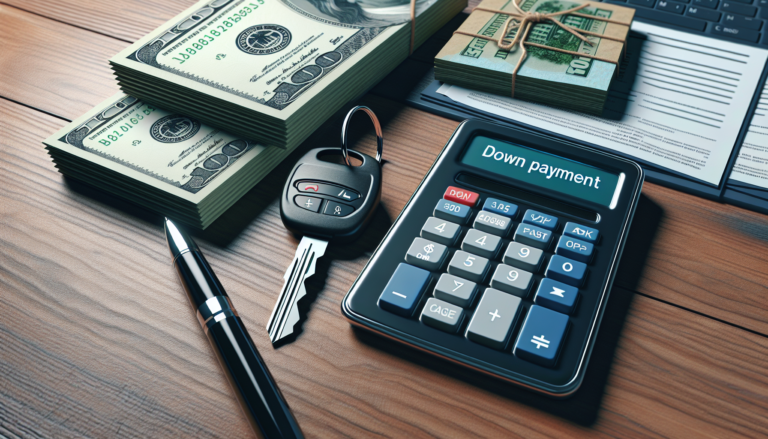Understanding Car Down Payments
When purchasing a vehicle, one of the most important considerations is the down payment. A down payment is an initial upfront payment made when buying a car, typically expressed as a percentage of the total price. The amount you put down can significantly impact your auto loan terms, monthly payments, and overall financial well-being.
What is a Down Payment?
A car down payment is the cash you pay upfront when buying a vehicle. It reduces the amount you need to borrow and can help secure better loan terms. The down payment is usually expressed as a percentage of the car’s total price, with common down payment percentages ranging from 10% to 20%.
Why is a Down Payment Important?
Making a substantial down payment on a car has several advantages:
- Lower monthly payments: A larger down payment means you borrow less money, resulting in lower monthly car loan payments.
- Better interest rates: Putting more money down can help you qualify for better interest rates, as lenders see you as a lower risk borrower.
- Reduced risk of being “upside down”: A higher down payment helps ensure that you don’t owe more than the car is worth, which can be problematic if you need to sell or trade in the vehicle.
Recommended Down Payment Amounts
While the ideal down payment amount varies depending on individual circumstances, there are general guidelines to consider for both new and used cars.
Down Payment for New Cars
For new vehicles, a down payment of at least 20% is often recommended. According to Kelley Blue Book, the average new car price is $47,401 with an average down payment of $7,074 (15%). Putting 20% down on a new car can help you secure better loan terms and avoid being “upside down” on your loan.
Down Payment for Used Cars
When buying a used car, a down payment of 10% to 20% is advisable. Used cars typically have lower price tags than new vehicles, so a smaller down payment percentage can still provide the benefits of reduced monthly payments and better loan terms.
The 20/4/10 Rule
A common guideline for car buying is the 20/4/10 rule. This rule suggests that you should:
- Put at least 20% down on the vehicle
- Finance the car for no more than 4 years (48 months)
- Ensure that your total monthly vehicle expenses (including loan payment, insurance, fuel, and maintenance) do not exceed 10% of your gross monthly income
Following this rule can help keep your car expenses manageable and prevent financial strain.
Factors Influencing Down Payment Amounts
Several factors can impact how much you should put down on a car, including interest rates, loan terms, credit scores, and vehicle depreciation.
Interest Rates and Loan Terms
The interest rate on your car loan can significantly affect your monthly payments and the total amount you pay over the life of the loan. Higher down payments often lead to lower interest rates, as lenders view borrowers who put more money down as less risky. Additionally, shorter loan terms (e.g., 36 or 48 months) can result in lower interest rates compared to longer terms (e.g., 60 or 72 months).
Credit Score Impact
Your credit score plays a crucial role in determining your auto loan interest rate and approval odds. Generally, a higher credit score leads to better loan terms and lower interest rates. If you have a lower credit score, making a larger down payment can help improve your chances of loan approval and securing more favorable terms.
Vehicle Depreciation
Cars depreciate in value over time, with new vehicles experiencing the most rapid depreciation in the first few years of ownership. Making a larger down payment can help offset the effects of depreciation, ensuring that you don’t owe more than the car is worth if you need to sell or trade it in.
Strategies to Increase Your Down Payment
If you’re struggling to come up with a substantial down payment, there are several strategies you can employ to increase the amount you put down on a car.
Using Trade-In Value
If you have a vehicle to trade in, its value can be applied towards your down payment. Research your current car’s trade-in value using resources like Kelley Blue Book to estimate how much it can contribute to your down payment.
Taking Advantage of Rebates
Many car manufacturers offer rebates and incentives that can be applied to your down payment. These offers can significantly reduce the upfront cost of purchasing a vehicle, allowing you to put more money down or lower your monthly payments.
Alternatives to Traditional Down Payments
In some cases, alternative options may be available for those who cannot make a significant down payment.
No Down Payment Options
Some lenders and car dealerships offer no down payment financing for borrowers with excellent credit. However, these loans often come with higher interest rates and longer loan terms, which can result in paying more overall. It’s essential to carefully consider the long-term costs before opting for a no down payment loan.
The Role of Gap Insurance
If you make a low down payment or have a longer loan term, gap insurance can provide added protection. Gap insurance covers the difference between what you owe on the car and what it’s worth if it’s totaled in an accident or stolen. This coverage can help prevent financial hardship if you find yourself “upside down” on your car loan.
See also:






